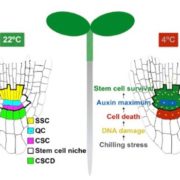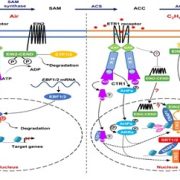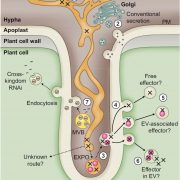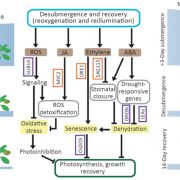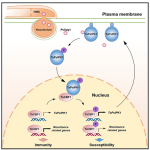Increasing the resilience of plant immunity to a warming climate (Nature)
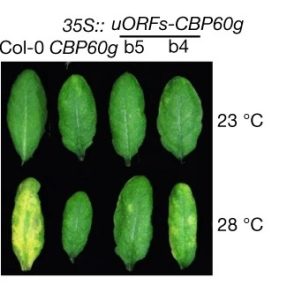 Plants demonstrate increased susceptibility to pathogens upon exposure to heat stress, apparently due to suppressed salicylic acid (SA) accumulation and subsequently decreased effector-triggered immunity. How exactly does heat stress cause this suppression, and how can we take advantage of genetics to increase plant resilience? Kim et al. discovered that heat stress acts on SA immunity pathways independent of established thermosensing mechanisms (specifically, phyB and ELF3). Rather, heat stress inhibits the formation of phase-separating condensates composed of GBPL3, a positive regulator of SA function that contains an intrinsically disordered region within its structure. GBPL3 condensates are necessary for proper transcription of CBP60g, which codes for a broad regulator of immune responses that binds to the promoter of the SA biosynthesis gene ICS1. Constitutive overexpression of CBP60g restored SA accumulation and associated immunity under heat stress, demonstrating a plant with increased resilience in the face of increasing temperatures. This genotype, however, presented a late flowering phenotype, in agreement with the growth-defense trade off; the authors thus fine-tuned their engineering by linking overexpressed CBP60g with uORFsTBF1, limiting CBP60g overexpression to pathogen infection events. This uORFsTBF1–CBP60g plant demonstrated increased resilience alongside wild-type development. Interestingly, overexpression of either GBPL3 or ICS1 did not restore immunity under heat stress, the former due to heat stress specifically inhibiting GBPL3 condensate formation, and the latter likely due to the broader role that CBP60g plays in plant immune responses. Altogether, this work highlights the power of genetic engineering to develop plants that can withstand climate change, and the importance of dissecting how physiological responses operate down to a molecular level of detail. (Summary by Benjamin Jin) Nature, 10.1038/s41586-022-04902-y
Plants demonstrate increased susceptibility to pathogens upon exposure to heat stress, apparently due to suppressed salicylic acid (SA) accumulation and subsequently decreased effector-triggered immunity. How exactly does heat stress cause this suppression, and how can we take advantage of genetics to increase plant resilience? Kim et al. discovered that heat stress acts on SA immunity pathways independent of established thermosensing mechanisms (specifically, phyB and ELF3). Rather, heat stress inhibits the formation of phase-separating condensates composed of GBPL3, a positive regulator of SA function that contains an intrinsically disordered region within its structure. GBPL3 condensates are necessary for proper transcription of CBP60g, which codes for a broad regulator of immune responses that binds to the promoter of the SA biosynthesis gene ICS1. Constitutive overexpression of CBP60g restored SA accumulation and associated immunity under heat stress, demonstrating a plant with increased resilience in the face of increasing temperatures. This genotype, however, presented a late flowering phenotype, in agreement with the growth-defense trade off; the authors thus fine-tuned their engineering by linking overexpressed CBP60g with uORFsTBF1, limiting CBP60g overexpression to pathogen infection events. This uORFsTBF1–CBP60g plant demonstrated increased resilience alongside wild-type development. Interestingly, overexpression of either GBPL3 or ICS1 did not restore immunity under heat stress, the former due to heat stress specifically inhibiting GBPL3 condensate formation, and the latter likely due to the broader role that CBP60g plays in plant immune responses. Altogether, this work highlights the power of genetic engineering to develop plants that can withstand climate change, and the importance of dissecting how physiological responses operate down to a molecular level of detail. (Summary by Benjamin Jin) Nature, 10.1038/s41586-022-04902-y


